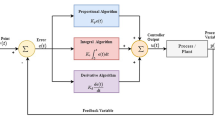Abstract
This paper continues the issue of improving automatic feedback control systems as one of the most important complexes in automated industrial process control systems (AIPCS). It is experimentally verified that Smith predictor represents an efficient tool to improve performance of delayed objects and high-order objects. Principles of operation and adjustment are described for the controller operating on the basis of the predictor. Digital controllers are demonstrated well-adapted for embedding the option of Smith predictor. Experimentally tested versions of the predictor’s program realization are suggested for the programmable controllers and PID controllers of industrial application.
Similar content being viewed by others
References
Bazhanov, V.L., Self-adjustment Function on the Basis of Scaling Method for Digital Controllers, Promyshl. Avtomatiz. Sist. Upravlen. Kontrollery, 2007, no. 12.
Bazhanov, V.L., Scaling Method as an Efficient Tool for Practical Adjustment of Controllers in Closedloop Automatic Control Systems, Pribory i Sistemy. Upravlen., Kontrol’ i Diagnostika, 2006, no. 6.
Author information
Authors and Affiliations
Additional information
Original Russian Text © V.L. Bazhanov, 2009, published in Avtomatizatsiya v Promyshlennosti, 2009, No. 8, pp. 15–20.
Rights and permissions
About this article
Cite this article
Bazhanov, V.L. Smith predictor in digital feedback control systems. Autom Remote Control 71, 1695–1704 (2010). https://doi.org/10.1134/S0005117910080175
Received:
Published:
Issue Date:
DOI: https://doi.org/10.1134/S0005117910080175




